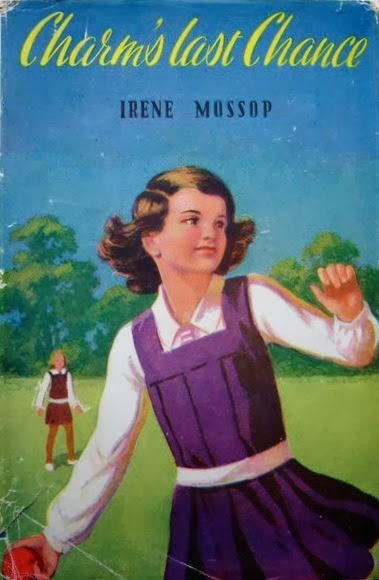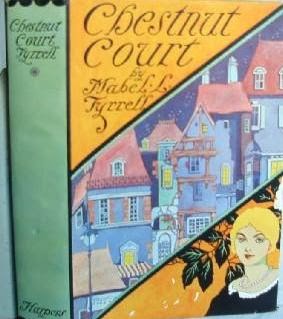For my third and final (for
now) update dedicated to mystery and romance authors, 17 more writers of
varying degrees of interest. I'm riveted
by the cover of MARGARET MACGILL's Her Dancing Partner, which, you have to
admit, is striking. What else it is might be up for discussion…
And imagine my surprise,
after all this time, to be adding an author to my list who actually has a book in print. Amazing but true, SYBIL G. BRINTON was the author of one of the earliest Jane Austen
sequels, Old Friends and New Fancies: An Imaginary Sequel to the Novels of Jane
Austen (1914). This novel, rather intriguingly, combines
previously unmated characters from all six Austen novels into a new romance. Reviews online seem to be mixed, but it is
actually in print from American publisher Sourcebooks.
FIONA SINCLAIR could be a rather intriguing
mystery author, but sadly she apparently committed suicide just as her career
was picking up, with the result that several of her novels were only published
posthumously.
And HELEN MARY KEYNES, who was the author of adventure and mystery
novels, is attracting me because of two late novels written under her pseudonym, Clementine Hunter—Salute to the Brave: A Thrilling Story of the Gestapo in England (1940),
and Queens Have Died Young and Fair (1947),
which, judging by its cover, is also set during wartime. I am a sucker for WWII novels, so perhaps I should be on the lookout for these.
Meanwhile, PHYLLIS MACVEAN
is another mystery novelist who was
quite prolific from the 1920s to the 1960s, mostly under her pseudonym Phyllis
Hambledon. She must have been rather
successful, and at least one of her novels, No
Difference to Me (1948), was adapted as the film No Place for Jennifer (1950), but this doesn't seem to make it easier
to find out much about her.
Another example of the essential perishability of fame!
I'm adding a couple more
rather mysterious figures as well. PHYLLIS
GORDON DEMAREST has already inspired
a fascinating research post here,
detailing some of the challenges of tracking down the most obscure
authors. And even expert researcher John
Herrington—who has often helped me out when I hit a wall in my search for an
author's details—was unable to trace ANNE STANTON DREW, who published
several romantic novels in the 1930s.
Intriguingly, he has found information leading him to believe that this
was the pseudonym of a well-known actress, but he's been unable to identify
which one. Ah, imagine the possibilities
of fantasizing about our favorite Thirties actresses secretly scribbling
romance novels!
And finally, although I know
precious little about her, ARMINE GRACE
is a satisfying addition to my list because I do love linking up family and
other kinds of relationships between women writers. Grace was the pseudonym of Amy Grace Catherine Lowdes, sister of Dorothy
Lowndes, who published novels under the pseudonym Dolf Wyllarde.
The complete list of 17
authors is below and has already been added to the main
list. Maybe you'll find others
of interest among them!
ELIZABETH MADELAINE C[AROLINE?]. BALFOUR-BROWNE (1876-1968)
(aka E. M.
C. Balfour-Browne)
|
|
Author of two story collections during my
time period—Solway Tides and Other
Tales (1928) and "If All
Tales…" (1936), as well as an earlier novel, The Beetaley Jewels (1901), which may be a mystery; little
information seems to be available about her.
|
|
JUDITH BRUNDRETT BICKLE (1886-1965)
(née Bower, aka J. Tweedale, aka Judith Tweedale)
|
|
Primarily known as a poet
(her Collected Poems appeared in
1948), Bickle also wrote two novels—The
Unimaginable Flowers (1935), described as a romantic novel, and Village of Rosemary (1965).
|
|
SYBIL G[????]. BRINTON
(dates unknown)
|
|
Apparently
the author of only one novel, Old
Friends and New Fancies: An Imaginary Sequel to the Novels of Jane Austen
(1914), which combined characters from all six Austen novels into a new
romance; the novel has been reprinted by Sourcebooks and is actually in print
as of this writing.
|
|
HAZEL [MARY FAITH]
(née Marlow)
|
|
Author
five mysteries and/or thrillers in the late 1920s and early 1930s, including The Servants of the Goddess (1928), The Secret Brotherhood (1929), The Burqa: A Detective Story (1930), The Makra Mystery (1931), and Olga Knaresbrook—Detective (1933).
|
|
ANN DELAMAIN (dates
unknown)
|
|
Author
of romantic novels including All Our
Dear Relations (1935), as well as intriguing later novels like The Best Butter (1948), about a bored
widow who adopts two children and runs for political office, and My Bee Stings (1949), about a
successful playwright facing the death of her husband.
|
|
PHYLLIS GORDON DEMAREST
(1908-1969)
|
|
A
somewhat mysterious author (see here),
Demarest published several novels in the 1930, including Lady Gone Wild (1933), The
Past Is Ours (1934), and This
Strange Love (1939), as well as at least two later ones, The Naked Risk (1954) and The Angelic City (1961).
|
|
ANNE STANTON DREW (c.
1890-????)
(pseudonym of ????)
|
|
Author
of at least five romantic novels in the 1930s—Overture (1931), Starlight
(1933), The Gay Road (1934), Haven (1935), and The Capable Girl (1937); according to John Herrington, this seems
to be the pseudonym of a well-known actress, but her true identity remains
murky.
|
|
ARMINE GRACE (1867-1939)
(pseudonym
of Amy Grace Catherine Lowdes)
|
|
Sister of Dorothy Lowndes (aka Dolf
Wyllarde), Grace also worked in the London theatre and published two novels
of her own, which sound as though they could be mysteries or thrillers—The Cloak of St. Martin (1913) and The House of Silent Footsteps (1917).
|
|
JOHN IRONSIDE
(1866-1945)
(pseudonym of Euphemia
Margaret Tait)
|
|
Author
of nine novels, most of them mysteries, in the 1910s to 1940s, including The Red Symbol (1911), Forged in Strong Fires (1912), The Call-Box Mystery (1923), Jack of Clubs (1931), The Marten Mystery (1933), Lady Pamela's Pearls (1941), and The Crime and the Casket (1945).
|
|
HELEN MARY KEYNES
(1892-1975)
(aka Clementine Hunter)
|
|
Author
of adventure and mystery novels, including The Spanish Marriage (1913), Honour
the King (1914), Salute to the
Brave: A Thrilling Story of the Gestapo in England (1940), and Queens Have Died Young and Fair (1947),
which, judging by its cover, may also be set in wartime.
|
|
MARGARET MACGILL
(1887-1966)
(née Gibbons, aka Margaret
Gibbons, aka Mrs. Patrick MacGill)
|
|
Author
of at least twenty romance novels from the 1910s to 1930s, including The Rose of Glenconnel (1916), The Bartered Bride (1920), Molly of the Lone Pine (1922), Love's Defiance (1926), Dancers in the Dark (1929), Painted Butterflies (1931), and Hollywood Madness (1936).
|
|
PHYLLIS MACVEAN
(1892-1967)
(aka Phyllis Hambledon)
|
|
Author
of romance and mystery novels from the 1920s to 1960s; titles include Autumn Fires (1926), Leading Strings (1932), Hogmanay (1935), Turn Over the Page (1943), Invitation
to Terror (1950), Keys for the
Criminal (1958), and Murder and
Miss Ming (1959).
|
|
SHIRLEY MURRELL (dates
unknown)
(pseudonym of Olive Scott
Hansen)
|
|
More
research needed; author of more than a dozen novels from the 1940s to 1970s,
about which little information is available; titles include Perilous Rock (1948), Physician Extraordinary (1949), Squire Neptune (1952), The Man from Martinique (1957), and The Young Josephine (1960).
|
|
MAX SALTMARSH (1893-1975)
(pseudonym of Marian
Winifred Saltmarsh, née Maxwell)
|
|
Author
of several mystery/thrillers of the 1930s, including Highly Unsafe (1936), Highly
Inflammable (1936), The Clouded
Moon (1937), and Indigo Death
(1938).
|
|
FIONA SINCLAIR
(1919-1963)
(pseudonym of Fiona
Peters, née Blaines)
|
|
Author
of several mystery novels in the early 1960s (just barely fitting my time
frame here), including Scandalize My
Name (1960), Dead of a Physician
(1961), Meddle with the Mafia
(1963), Three Slips to a Noose (1964),
and Most Unnatural Murder (1965).
|
|
MARIGOLD WATNEY
(1886-????)
|
|
Author
of more than a dozen novels 1932-1960, at least one of which—Laugh When You Can (1945)—was a murder
mystery; other titles include Ducks on
a Pond (1932), What Shall We Do
with Anne? (1937), Her Name Was
Cornelia (1947), and The Other Side
of the Wall (1949).
|
|
I. WRAY (1894-1969)
(pseudonym of Iris Elaine
Bickford, married name Palliser)
|
|
Author
of two mystery novels in the early 1930s; The
Vye Murder (1930) was praised by The
Spectator for its portrayal of women, and Murder—and Ariadne (1931), is about a murder following a “rowdy
house party” and was praised by the West
Australian as “ingeniously constructed.”
| |



+-+Queens+Have+Died+Young+and+Fair'.jpg)




.jpg)






























.jpg)
.jpg)
.jpg)


















